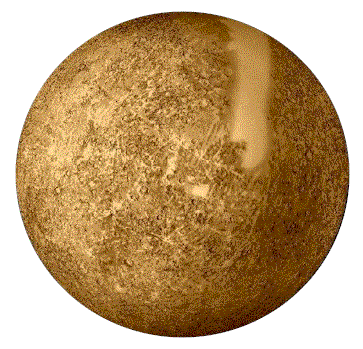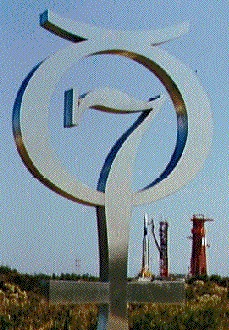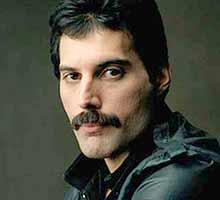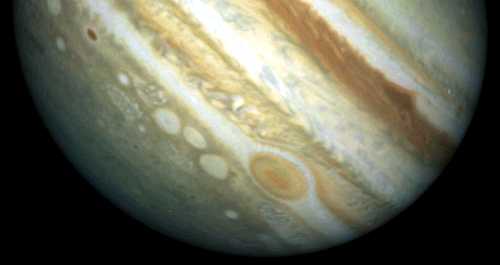

orbit: 57,910,000 km (0.38 AU) from Sun diameter: 4,880 km mass: 3.30e23 kg
In Roman mythology Mercury is the god of commerce, travel and thievery, the Roman counterpart of the Greek god Hermes, the messenger of the Gods. The planet probably received this name because it moves so quickly across the sky. Mercury has been known since at least the time of the Sumerians (3rd millennium BC). It was given two names by the Greeks: Apollo for its apparition as a morning star and Hermes as an evening star. Greek astronomers knew, however, that the two names referred to the same body. Heraclitus even believed that Mercury and Venus orbit the Sun, not the Earth.
Mercury has been visited by only one spacecraft, Mariner 10. It flew by three times in 1974 and 1975. Only 45% of the surface was mapped (and, unfortunately, it is too close to the Sun to be safely imaged by HST).
Mercury’s orbit is highly eccentric; at perihelion it is only 46 million km from the Sun but at aphelion it is 70 million. The perihelion of its orbit precesses around the Sun at a very slow rate. 19th century astronomers made very careful observations of Mercury’s orbital parameters but could not adequately explain them using Newtonian mechanics. The tiny differences between the observed and predicted values were a minor but nagging problem for many decades. It was thought that another planet (sometimes called Vulcan) might exist in an orbit near Mercury’s to account for the discrepancy. The real answer turned out to be much more dramatic: Einstein’s General Theory of Relativity! Its correct prediction of the motions of Mercury was an important factor in the early acceptance of the theory.
Until 1962 it was thought that Mercury’s “day” was the same length as its “year” so as to keep that same face to the Sun much as the Moon does to the Earth. But this was shown to be false in 1965 by doppler radar observations. It is now known that Mercury rotates three times in two of its years. Mercury is the only body in the solar system known to have an orbital/rotational resonance with a ratio other than 1:1 (though many have no resonances at all).
This fact and the high eccentricity of Mercury’s orbit would produce very strange effects for an observer on Mercury’s surface. At some longitudes the observer would see the Sun rise and then gradually increase in apparent size as it slowly moved toward the zenith. At that point the Sun would stop, briefly reverse course, and stop again before resuming its path toward the horizon and decreasing in apparent size. All the while the stars would be moving three times faster across the sky. Observers at other points on Mercury’s surface would see different but equally bizarre motions.
Temperature variations on Mercury are the most extreme in the solar system ranging from 90 K to 700 K. The temperature on Venus is slightly hotter but very stable.
Mercury is in many ways similar to the Moon: its surface is heavily cratered and very old; it has no plate tectonics. On the other hand, Mercury is much denser than the Moon (5.43 gm/cm3 vs 3.34). Mercury is the second densest major body in the solar system, after Earth. Actually Earth’s density is due in part to gravitational compression; if not for this, Mercury would be denser than Earth. This indicates that Mercury’s dense iron core is relatively larger than Earth’s, probably comprising the majority of the planet. Mercury therefore has only a relatively thin silicate mantle and crust.
Mercury’s interior is dominated by a large iron core whose radius is 1800 to 1900 km. The silicate outer shell (analogous to Earth’s mantle and crust) is only 500 to 600 km thick. At least some of the core is probably molten.
Mercury actually has a very thin atmosphere consisting of atoms blasted off its surface by the solar wind. Because Mercury is so hot, these atoms quickly escape into space. Thus in contrast to the Earth and Venus whose atmospheres are stable, Mercury’s atmosphere is constantly being replenished.
The surface of Mercury exhibits enormous escarpments, some up to hundreds of kilometers in length and as much as three kilometers high. Some cut thru the rings of craters and other features in such a way as to indicate that they were formed by compression. It is estimated that the surface area of Mercury shrank by about 0.1% (or a decrease of about 1 km in the planet’s radius).
One of the largest features on Mercury’s surface is the Caloris Basin (right); it is about 1300 km in diameter. It is thought to be similar to the large basins (maria) on the Moon. Like the lunar basins, it was probably caused by a very large impact early in the history of the solar system. That impact was probably also responsible for the odd terrain on the exact opposite side of the planet (left).
In addition to the heavily cratered terrain, Mercury also has regions of relatively smooth plains. Some may be the result of ancient volcanic activity but some may be the result of the deposition of ejecta from cratering impacts.
A reanalysis of the Mariner data provides some preliminary evidence of recent volcanism on Mercury. But more data will be needed for confirmation.
Amazingly, radar observations of Mercury’s north pole (a region not mapped by Mariner 10) show evidence of water ice in the protected shadows of some craters.
Mercury has a small magnetic field whose strength is about 1% of Earth’s.
Mercury has no known satellites.
Mercury is often visible with binoculars or even the unaided eye, but it is always very near the Sun and difficult to see in the twilight sky. There are several Web sites that show the current position of Mercury (and the other planets) in the sky. More detailed and customized charts can be created with a planetarium program such as Starry Night.
Open Issues
Mercury’s density (5.43 gm/cm3) is nearly as high as Earth’s. Yet in most other respects it more closely resembles the Moon. Did it lose its light rocks in some early catastrophic impact?
No trace of iron has been seen in spectroscopic studies of Mercury’s surface. Given its presumably large iron core this is very odd. Is Mercury much more completely differentiated than the other terrestrial planets?
What processes produced Mercury’s smooth plains?
Are there any surprises on the other half of the surface we’ve not seen? Low resolution radar images obtained from Earth show no surprises, but you never know.
A new discovery-class mission to Mercury has been approved. MESSENGER will launch in 2004 and orbit Mercury starting in 2009.
Mercury / Hermes
The Gods work in mysterious ways….but sometimes they just got to get the message across pretty bluntly. So, in absence of some kind of Olympus Telephone Company, who are they going To call but the chief messenger. In Greek mythology that was Hermes. In later years, the Romans called that god Mercury. As a god, he was the swiftest–nobody could get there faster than Hermes. When the planets were given names related to the gods, back in the ancient days of Greek astronomy, the fastest planet was named for the winged one.
BIOGRAPHY
Hermes is the son of Zeus and Maia, goddess of clouds and one of the Pleiades, the seven daughters of Atlas. He was born in Arcadia, near the mountain Cyllene. He was washed by nymphs at the mountain Tricrena, also in Arcadia. While some babies enjoy rubber duckies, Hermes’ holy-bird was Gallus, the cock or rooster (also known these days as a messenger of sorts). The ram (as in Aries) is also considered one of Hermes’ favored pets.
A precocious youth, he stole a herd of cows from Apollo, a mere five minutes after he was born. From some of the cows’ internal guts, er, fibers, young Hermes put together the lyre, a kind of handheld harp, upon which Apollo made the best music in the universe. On this basis, Hermes became the patron of trickster and thieves, and was forgiven for his transgression by Apollo. For himself, Hermes made the shepherd-pipe, similar to the pipes used by his future son, Pan.
No wire of Hermes has been clearly identified. He, therefore, was rather promiscuous, but then, so were all the rest of the Greek gods. With liasons with the goddess of love and beauty, Aphrodite, another offspring of Zeus, he had a daughter, Peitho, the personification of persuasion and seduction. Apparently they had at least two more daughters, Tyche and Eunomia. They also had a son, Hermaphroditus, an offspring having a great relationship with both his masculine and feminine sides. In some mythological stories, the two Olympians also were parents of Eros though this is disputed.
A liaison with Penelope produced a son, Pan. This personage is, of course, well known as the pipe playing god of shepherds, and if not as quick as Dad, was definitely a swift runner.
As befits the patron of thieves, another son became the great thief Autolycus. Autolycus was the offspring of Chione and Hermes, and the grandfather of hero Odysseus. Hermes later helps rescue his great-grandson (twice) from harm during the latter’s 10-year, post-Trojan War “Odyssey.”
The Bacchus-like Silenus is sometimes claimed to be Hermes son and Pan’s brother, some legends say he is Pan’s son. And there are many more sons and daughters, including some of the Argonauts. Hermes….was no hermit.
RESIDENCES
After changing heavenly citizenship roles (from Egyptian deity to Greek) his Egyptian center of worship became known as Hermopolis. In Rome he had a temple near the Circus Maximus, on Aventine Hill. It was the site of a trade fair. Mercury also had a well near the Porta Capena.
CELEBRATIONS
The principal holiday for the merchant god was Mercuralia, May 15th (Drat! Missed it!). Among the Celtics and Germans existed cults of Mercury worshippers.
As one of the five “moving stars” or “planets”, Mercury’s name is the origin of “Wednesday.” In French, this is ‘mercredi’, coming from the Latin ‘Mercurii dies’, or Mercury’s day.
WORK HISTORY
Hermes served as messenger for Zeus (though sometimes he job-shares with Iris, the goddess of the dawn) and as sometime conductor of souls of the dead to Hades. He was also known as “the guide and giver of good.” As one of Jupiter’s favorites (as Mercury) he was considered the most entertaining, the most shrewd and the most resourceful god. When Jupiter tired of Olympus, he chose Mercury to accompany him on forays to Earth, both disguised as mortals.
In his job as messenger, he wears a broad-rimmed traveller’s hat called a petasos or petasus, talaria or winged sandals made “of imperishable gold whcih bore him swift as a breath of air over sea and earth,” and carries a cadeuceus or herald’s staff around which serpents or ribbons may be found. The cadeuceus is said to be able to charm men’s eyes to sleep.He also carries a purse (more like a money-bag actually….). The purse signifies his role as the Greek god of riches, trade and good fortune and the Roman god of trade, profit, merchants and travellers. He took over the latter job from the Dei Lucre, early Roman deities of commerce (from which, I suspect, comes the phrase “filthy lucre”). Hermes also changed his name to Mercury. Among his personal favorite commercial activities was the corn trade. Mercury’s relationship to business and speed survive in words like “mercurial” and mercantile.” Because of his speed he is sometimes considered a god of the winds.
To the Babylonians he was viewed as the bearer of riches. To the astrologers of the Renaissance he was the bringer of misfortune.
SYMBOL

Mercury’s `corporate logo’ is often described as representing the messenger’s cadeuceus or wand with two snakes curled around it. In some versions of the logo’s origin it is said to be Mercury in his winged hat or petasos.
| Mercury80 Hg 200.59 |
| Properties |
|---|
| Symbol | Name | Atomic Number | Atomic Weight | Group Number |
|---|---|---|---|---|
| Hg | Mercury | 80 | 200.59 | 12 |
Description
Standard State: liquid at 298 K (the heaviest known elemental liquid)
Color: silvery white
Mercury was known the the Chinese and Hindus, and also found in Egyptian tombs of 1500 B.C. Mercury is the only common metal liquid at ordinary temperatures and rarely occurs free in nature.
It is a heavy, silvery white metal; a rather poor conductor of heat, as compared with other metals, and a fair conductor of electricity. It easily forms alloys with many metals, such as gold, silver and time which are called amalgams. The metal is widely used laboratory work for making thermometers, barometers, diffusion ion pumps and many other instruments. Mercury should be handled with care because of the absorbing through the skin and can cause many problems (very serious ones).

Project Mercury:
Initiated in 1958, completed in 1963, Project Mercury was the United States’ first man-in-space program. The objectives of the program, which made six manned flights from 1961 to 1963, were specific:
- To orbit a manned spacecraft around Earth;
- To investigate man’s ability to function in space;
- To recover both man and spacecraft safely.
Mercury the Car





